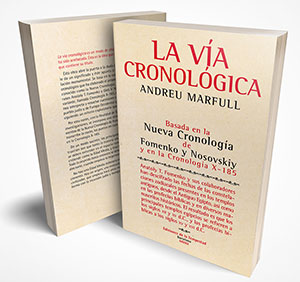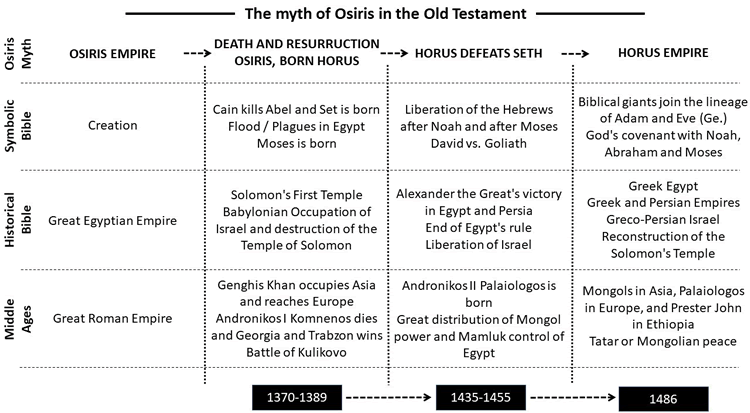Chapter of the book:
See Book 'The chronological way', in Spanish
© Andreu Marfull Pujadas
© de esta edición: Ediciones de La Tempestad SL, 2020
Barcelona, mayo de 2020
ISBN 978 84 121768 1 0

According to the reconstruction that is transcribed here, together with the Tatar and Mongolian expansion, a priestly body is created that preaches the grace of God associated with an imperial lineage, which with the glory of Genghis Khan becomes universal. With this, the Kingdom of God merges with the birth of a new power that wishes to rule the world, establishing itself as the "chosen", or "anointed". The Tatar or Mongolian power thus creates the glory of a divinized being, who returns to his original land to take control of the main symbolic empire: the Holy Land of the Nile.
It is the resurrection of the "divine" power of Osiris, which acquires another identity in Horus. Behind it is the takeover of Egypt, from multiple narratives, such as that of the wrath of the God of the Hebrews in the time of Moses. But there is also the equivalent story of Alexander the Great, who also frees the Jews and allows them to take control of Egypt. For this reason, the official history has written that Alexander the Great "rises" as a new God, and equates him to Amun (or Amen, which is how it is pronounced in the Egyptian language). That is to say, Amun in Alexander is also Horus, and in turn is Christ, and his power comes from the Tatar or Mongol arm, which is also Jewish. And for the same reason, the Jewish people celebrate the liberation from the Babylonian yoke with the feast of Hanukkah,also known as the Festival of Lights. With this symbolism the liberation of the Jewish people in the hands of the Greco-Persians and the reconstruction of the Temple of Solomon are commemorated. Historically, it has been traced back to the time of the great Alexander the Great, whom Jews have traditionally honored calling their first-born sons Alexander, ever since. (1)
Everything is the same story.
Figure 27 stages this episode, and shows its historical, Egyptian, Biblical and medieval meaning, and is articulated in the form of the Osiris myth, from the death of the same at the hands of Seth (his brother) to his resurrection through the Isis intercession, which manages to father Horus; going through the subsequent fight between Horus and Seth, in which the first one wins. It is Sacred History, which has come down to us written in multiple forms.

Figure 27. Equivalences the myth of Osiris with the Old Testament and the Middle Ages. Source: self made.
Figure 27 can be summarized in four narratives (The Osiris Myth, the Symbolic Bible, the Historical Bible and the Middle Ages), and in the transition of the Osiris empire into Horus, in a process that lasts approximately 116 years, where biblical history has turned years into centuries and sent them more than a thousand years into the past. But in reality, the events occurred six centuries ago, between the years 1370 and 1486.
Then, the death of Osiris before his brother Seth, after which Osiris resurrects and conceives Horus, with Isis, is
- Abel's death before Cain, and after that Eva conceives Set, to fill Abel's emptiness;
- the sacrifice of the parents of Moses and their adoption with the Pharaoh;
- the failed first Temple of Solomon, which is destroyed by the king of Babylon, despite the fact that the Jews maintain their prestige;
- the death of Andronikos Komnenos in 1370 (the official 1185) and the subsequent reconstruction of his power with the appearance of the Kingdom of Georgia and the Empire of Trebizond, in the alternative year 1389 (the official 1204), and the Battle of Kulikovo, of 1380, after which a distribution of powers between Mongols is agreed; and
- the invasion of all Asia, Persia and half Europe by Genghis Khan, who allies himself with the Keraites, after submitting them (in the same way that the king of Babylon Nebuchadnezzar subdues the Biblical people of Israel and then allies himself with them).
In this initial scenario,
- Osiris is Andronikos Komnenos;
- Seth are the king of Babylon, Nebuchadnezzar, Isaac Angelos (family of Andronicus, and who makes him kill) and Genghis Khan;
- Isis is the adoptive mother of Moses (Pharaoh's sister) and Queen Tamar of Georgia; and
- Horus are Moses and King-Emperor David of Georgia and Trabzon.
The fight between Seth and Horus is
- the chronicle of the Great Flood;
- that of the plagues of the angry God against the Pharaoh;
- the destruction of the First Temple of Solomon by the king of Babylon; and
- the Mongolian occupation of Persia and half the known world.
Horus's victory over Seth is
- that of David against Goliath, and the subsequent glory of the kingdoms of Judah and Israel;
- that of Alexander the Great over Egypt and Persia, Babylon, in which Israel is liberated and the Temple of Solomon is rebuilt;
- that of the Mamluks over Egypt (1250 official year, 1435 alternative), resulting in the Palaoilogos at the head of the Greek or Roman Empire (1261 official year, 1446 alternate), Prester John at the head of the Imperial House of Ethiopia (year 1270 official, 1455 alternative) and the division of the entire Mongolian Empire into great powers belonging to a main lineage.
The great pact between East and West is
- the birth of a great lineage, fused with the ancient powers, which Genesis (Ge. 6) assimilates to the union between the Giants and the sons of Adam and Eve, before the Flood;
- the Ark of the Covenant, the covenant of God with Humanity in the time of Noah, Abraham and Moses;
- the covenant of the "Alexandrian" empires of Greece, Egypt and Persia, after which the Second Temple of Solomon is created;
- the Tatar or Mongolian Peace Pact, in which trade relations from China to Europe flourish, and the medieval Greek Empire; and
- the covenant of the Ark of the Covenant that is guarded in the Kingdom of the Prester John, of the Imperial House of Ethiopia, "descendant" the kings Solomon and Sheba, which the Apocalypse dates in the year 1486.
After which arises
- the glory of the Gnostic Christ in Jerusalem and that of the Buddha in the East.
And, in this context, the Exodus from Babylon is
- the result of the "covenant" between Israel and Babylon to rule together, which is described in the Bible; as well as
- the alliance between Genghis Khan and the Keraites (the previous Hebrews to the Jews who follow the Law of Moses).
And, the so-called "Second Exodus from Babylon", which is assimilated to the Avignon papacy, is
- the project of the renewed Temple of Solomon, after the great Alliance, in which the Jewish princes are protagonists.
In this way, after this great struggle, a new God is built and another History begins. Alexandria is founded and the Bible is written there, beginning with the main book, the one that God dictates to Moses (the Torah) and the one that is honored by the Jews throughout history, from Genesis to Moses.
When Egypt is taken over, everything changes. Osiris mutates and remains in Egypt, but Horus is reborn from him in the form of an omnipotent God, Yahweh, and an emperor who takes various names: Jesus, Buddha or Krishna, and with them various spiritual schools are created, which are guarded under the priestly authority of Prester John, of the House of Solomon. Muhammad, in this context, appears associated with the Queen of Sheba, sharing common land: present-day Saudi Arabia, and is undoubtedly part of this crucial episode in history, surely, at the stage of the return to Egypt and in the establishment of the great pact between East and West, after the feat of Alexander the Great.
In turn, in the Christian tradition, it is the story that has commemorated Saint Thomas, who goes to India and meets the Three Kings, who bless him and give power to Prester John, thus beginning Christianity, in the same area of influence of the Buddha. Thomas means "twin", and the New Testament assimilates it with the twin of Jesus, thus hiding his inalienable relationship. That is, "twin" refers to a duplicate, and tells us about its "birth". The manuscript El Becerro (Fernández de Mendoza, n.d.) describes it in great detail. (2)
Later, some gospels are created from which the idea arises (with the passage of time) of creating a New Testament, giving shape to the ancient historicity of Jesus, as reflected in the attached Figure 28.

Figure 28. Equivalences of the Osiris myth with the New Testament. Source: self made.
The correlations are evident. The symbolic history is the same, but the official one has (almost) nothing to do with it.
In this way, the essence of the great parable of history that the Bible fakes is resolved, both in the Old and New Testaments, as well as in Genesis, the Torah and the ancient and medieval stories.
With just over a century actually documented, thousands of years of long history have been built.
In this way, the X-185 timeline reconstructs in turn the moment in which the organized religious idea was born, in the fifteenth century, and points to the following two centuries the religious dispersion, along the lines proposed by the New Chronology of Fomenko and Nosovskiy, but another interpretation is given. Before, the cult of the polytheistic tradition developed, which persisted until the seventeenth century, and it was then that its deliberate dismantling began, in order to reunite the religious dispersion into one of the principal, the Christian, and thus begin the "colonization". And, when this happens, an extensive history is constructed from the long biblical history, this time definitive and monumental, which has lost consciousness of its true origin.
(1) Contribution of M. Ferrús.
(2) The cited manuscript is worked on in the “Preface 2” section.